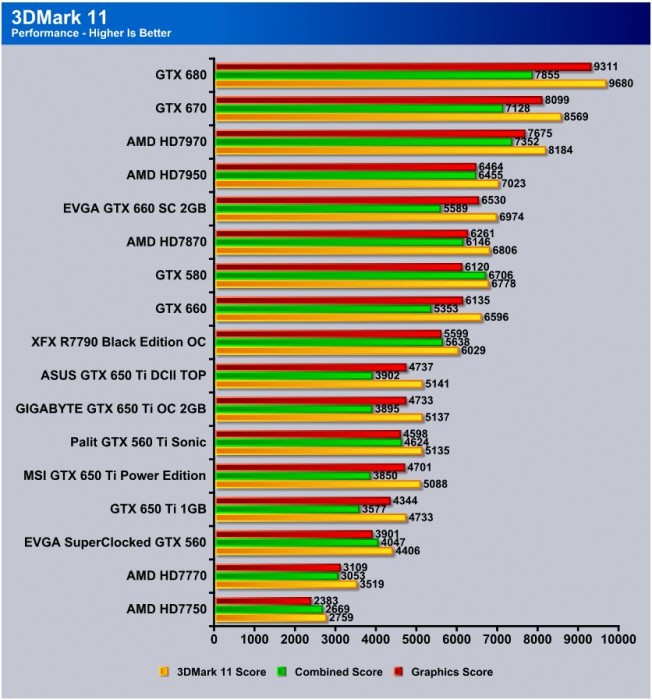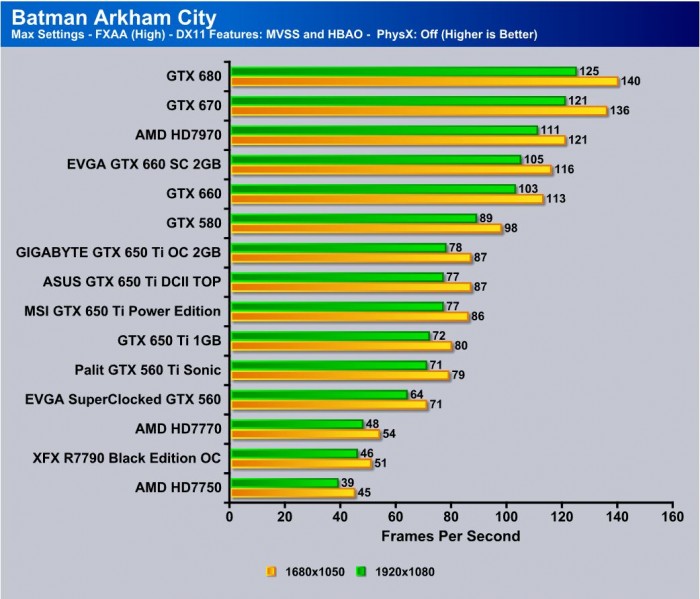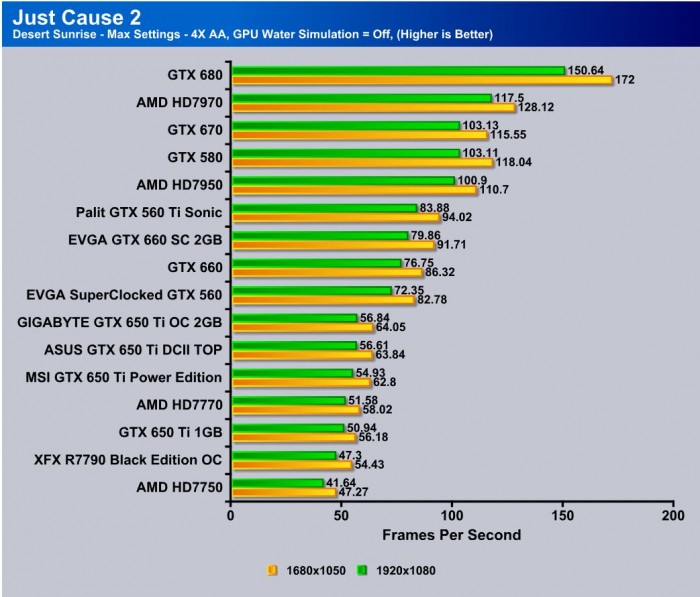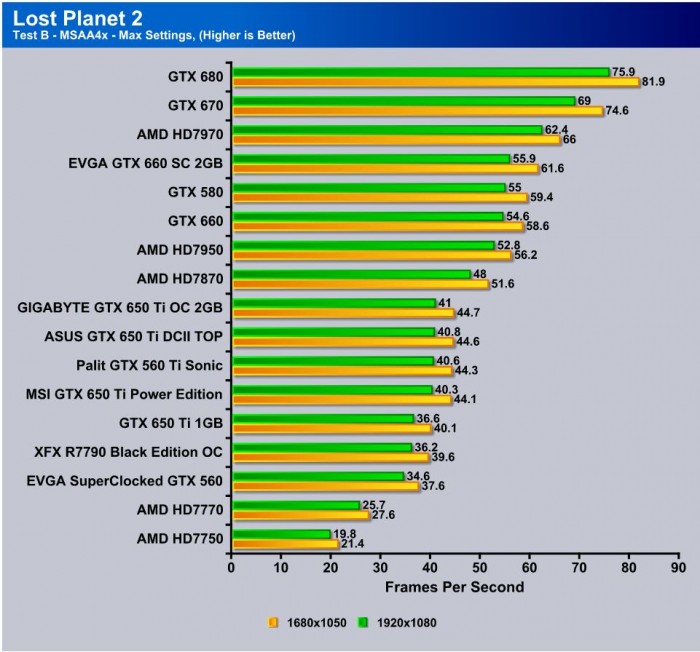XFX R7790 Black Edition 1GB Graphics Card
Testing & Methodology
We’ve expanded our testing suite considerably since the X79 chipset release, and will continue to use the same methods for most of the motherboards and CPU’s we test. In the interests of thoroughness and accurate results, we run each test at least three times, and some tests more than that. We average the total of all the tests from each benchmark then report the average here.
The OS we use is Windows 7 Pro 64bit with all patches and updates applied. We also use the latest drivers available for the motherboard and any devices attached to the computer. We do not disable background tasks or tweak the OS or system in any way. We turn off drive indexing and daily defragging. We also turn off Prefetch and Superfetch. This is not an attempt to produce bigger benchmark numbers. Drive indexing and defragging can interfere with testing and produce confusing numbers. If a test were to be run while a drive was being indexed or defragged, and then the same test was later run when these processes were off, the two results would be contradictory and erroneous. As we cannot control when defragging and indexing occur precisely enough to guarantee that they won’t interfere with testing, we opt to disable the features entirely.
Prefetch tries to predict what users will load the next time they boot the machine by caching the relevant files and storing them for later use. We want to learn how the program runs without any of the files being cached, and we disable it so that each test run we do not have to clear Prefetch to get accurate numbers. Lastly we disable Superfetch. Superfetch loads often-used programs into the memory. It is one of the reasons that Windows occupies so much memory. Vista fills the memory in an attempt to predict what users will load. Having one test run with files cached, and another test run with the files un-cached would result in inaccurate numbers. Again, since we can’t control its timings so precisely, it we turn it off. Because these four features can potentially interfere with benchmarking, and and are out of our control, we disable them. We do not disable anything else.
We are revamping our testing method in order to better represent motherboard performance and offering to the consumer. Also we want to make it an easier read for you without miles of endless charts. We ask that you provide feedback in an effort to help us deliver better reviews for you.
Test Rig
| Test Rig | |
| Case | Open Air Test Bench |
| CPU | Intel Core i7-3770K |
| Motherboard | ASUS Maximus V Formula |
| Ram | 16GB Patriot Viper Xtreme 2400MHz + |
| CPU Cooler | Swiftech H20-320 Edge |
| Hard Drive | Western Digital Velociraptor 300GB |
| SSD | Intel 510 series SATA III 120GB |
| Optical | ASUS BD-ROM |
| GPU | XFX R7790 Black Edition |
| Additional Cards |
N/A |
| PSU | Thermaltake Toughpower XT 1475W |
| Mouse | Tt eSPORTS Theron gaming mouse |
| Keyboard | Tt eSPORTS Meka G1 mechanical gaming keyboard |
Test Suite
We will use the following applications to test the performance of the graphics card.
Synthetic Benchmarks & Games
| Benchmarks |
|---|
| 3DMark11 |
| Batman Arkham City |
| Just Cause 2 |
| Lost Planet 2 |
| Metro 2033 |
| Heaven Benchmark |
| Battlefield 3 |
Overclocking
The XFX card much like all of the other cards we tested pulled a very nice overclock and very easy we must add up to 1200MHz and then dead stopped by the limit on the Catalyst driver.
With the cooling properties of the Double Dissipation cooler we am sure theres some definite room here just waiting to be exploited.
We am very excited for when someone cracks teh software limit so we can see what kind of headroom these gpus really have as we wonder why AMD would put such a strict limit on a very capable GPU.
As the other models have been noted you can expect approximately 6-7% increase depending upon the app from overclocking to the max 1200MHz and we can definitely say that from all of the units we have tested all are fully stable without issue at that speed with no hiccups and no thermal concerns on their stock cooling solutions.
In order to ensure no system bottleneck we clocked the CPU to 4.6GHz to ensure there is no reason the system will slow down the card’s performance at all.
Some may ask why we chose the mainstream Z77 system, and we can explain. Up until recent the X79 enthusiasts platform did not really support PCI-E Gen 3 on the Nvidia 600 series GPU’s. Because of the inherent instability many have seen with the X79 platform with Gen 3 products, Nvidia has been hesitant to enable it, and now there is a workaround via registry to get it working. However, in order to ensure the most consistent testing possible, we have stuck to the natively supported Z77 platform.
Important note: Overclocking can cause component failure. Please exercise caution when attempting any level of overclock on system components.
Temperatures
The temperatures were recorded with full loaded Heaven benchmark looping for over 30 minutes or longer depending how long it took for the card to level out in temps and sat at a plateau for more than 10 minutes.
| GPU Temperatures | Temperature (Idle/Load) |
| R7790 OC | 30C/62C |
| R7790 | 30C/59C |
The Double Dissipation cooler definitely kept things nice and cool even at full tilt 1200MHz under a long heaven benchmark loading we saw a maximum obtained thermal reading of 62C on the GPU and that was only a very short time as it hovered around 60-61C most of the time after a long burn time. Also it should be noted that the cooler stayed very quiet when testing on par or possibly a little better than the other 7790 cards I have tested.
Real world/Gaming Benchmarks
3DMARK 11
3DMark 11 is the newest in Futuremark’s suite of benchmarking utilities. Its a fully capable DirectX11 benchmark which also stresses and analyzes the system performance as a whole to simulate a heavy rendering environment such as a high end game or other app the end user may run. This benchmark was run with Performance settings 5 times and all runs were averaged for the result below.
Here like cards before you can see the positioning is right on par with the crowd of other 7790 models we have tested to date. We will give them this, the 7790 GPU is very consistent clock for clock.
Batman Arkham City
Batman Arkham city is one of those games that is just downright fun, and also it is nice as it gives very repeatable results for a game test. PhysX is disabled to level the playing field due to the fact that it would load the GPU on Nvidia based cards more to add the pretty effects which could hinder framerates giving AMD an advantage.
Here The 7790 falls in once again, and we cannot state it enough that we hope for a better driver soon as we think some optimization fell between the cracks on AMD’s side of this and once we have a few driver releases behind us is when this card will really shine.
Just Cause 2
Just Cause 2 has been in my stable of games for awhile, and is quite graphics intensive so we try to bring it out as it is a fun all around game and allows a nice test of a cards capabilities.
Here again the 7790 is in its friendly group and behind the 7770 again which just seems odd to me.
Lost Planet 2
Lost planet 2 even for being a bit older tends to offer a very good load even keeping top end GPU’s capped at a little over 60 FPS so it is definitely a good tool to put the hurt on a more mainstream value card.
Lost Planet 2 plays pretty nice with the 7790 as at max settings you can see very playable framerate averages.
Metro 2033
Metro 2033 likely one of the most demanding games that we have tested with, as it brings virtually every GPU to its knees. Here the 7790 once again can impress as at max detail it teeters between playable average and slightly under, but AMD definitely works well with Metro as we remember just one short year or so ago when a top end GPU would struggle for top settings to reach 30FPS.
Heaven Benchmark
Unigine Heaven is a very popular benchmark, but due to the fact I am still working on validating the repeatability of scores on the new 4.0 version I decided to stick with the 3.0 version for this test.
Here the R7790 takes a nice spot still a bit behind the GTX 660 but thats not really a surprise honestly as the GTX 660 is quite a leap ahead in positioning, but the 7790 crushes the likes of the 650 Ti and even previous gen GTX 560.
Battlefield 3
Battlefield 3 is probably one of the most popular FPS titles, and with its range of graphics capabilities definitely a fitting test as it also is played by a alrge part of the PC Gaming crowd.
Battlefield 3 is a very pleasing “eye candy” game and very fun to play as well. The R7790 from XFX does rather well at maximum ULTRA presets and it maintains an average in the 30 FPS range or a little higher is a major achievement Now as we noted before you will have to tune down the detail a little in favor of much smoother gameplay as ultra settings and high settings still show plenty of eye candy.
 Bjorn3D.com Bjorn3d.com – Satisfying Your Daily Tech Cravings Since 1996
Bjorn3D.com Bjorn3d.com – Satisfying Your Daily Tech Cravings Since 1996





















Thank you for sharing. Your post worth of reading. Waiting for new posts. buyincoins, where you can buy good products from China directly without any shipping fee.